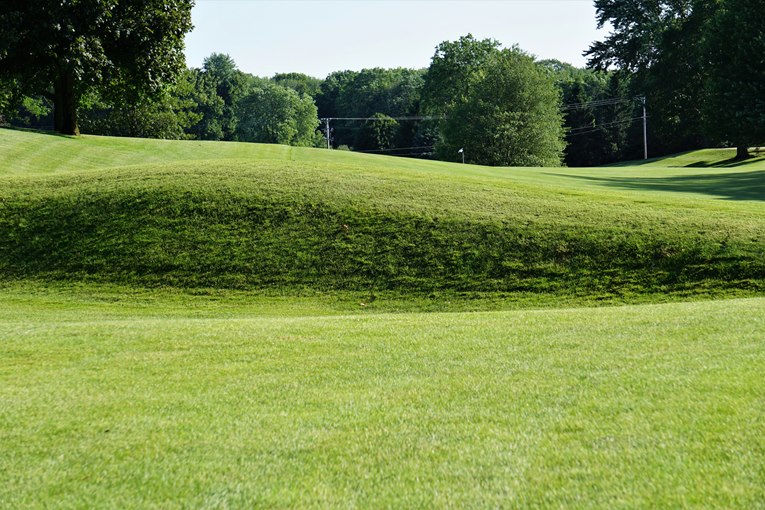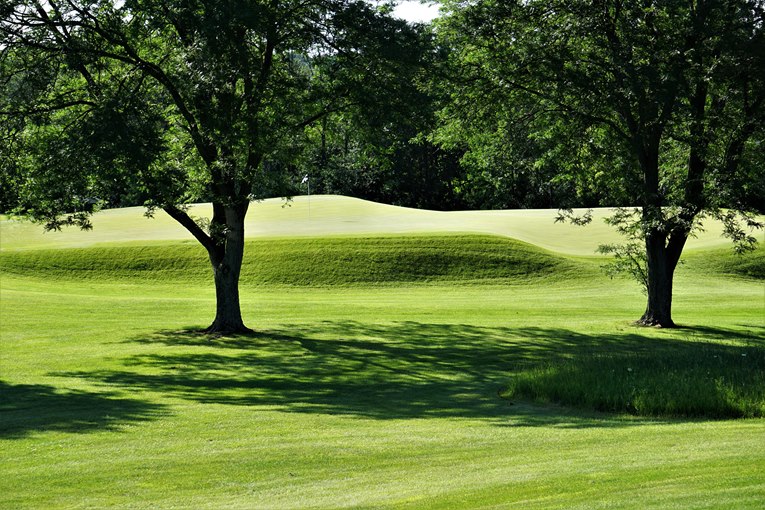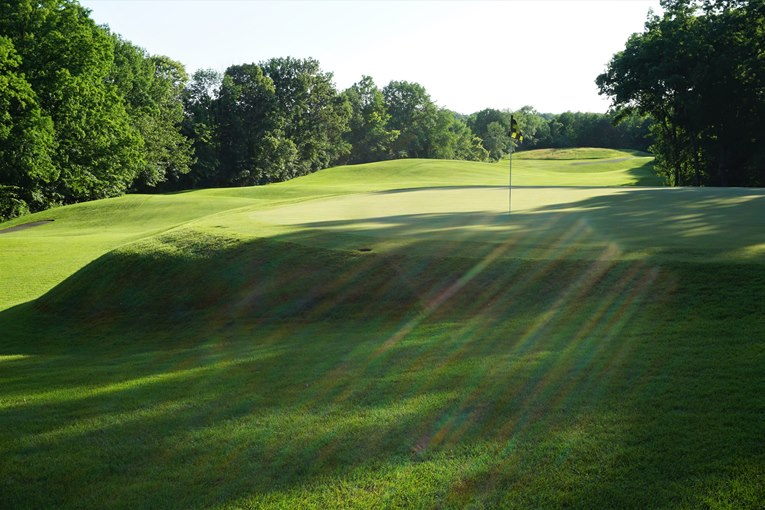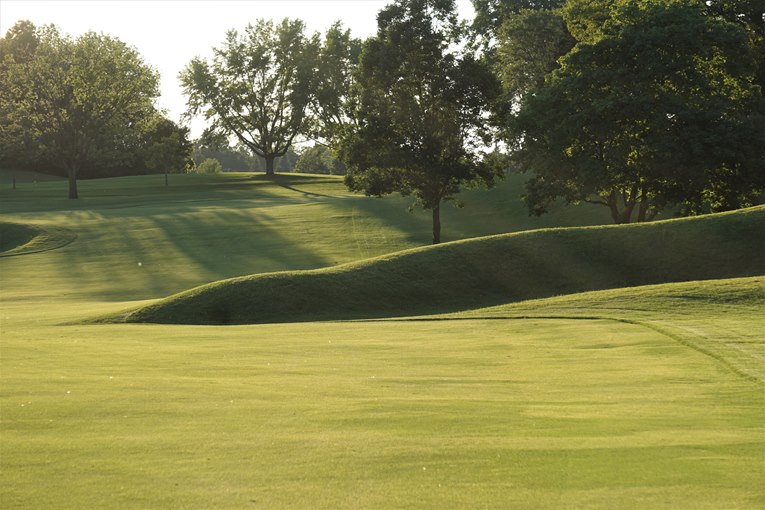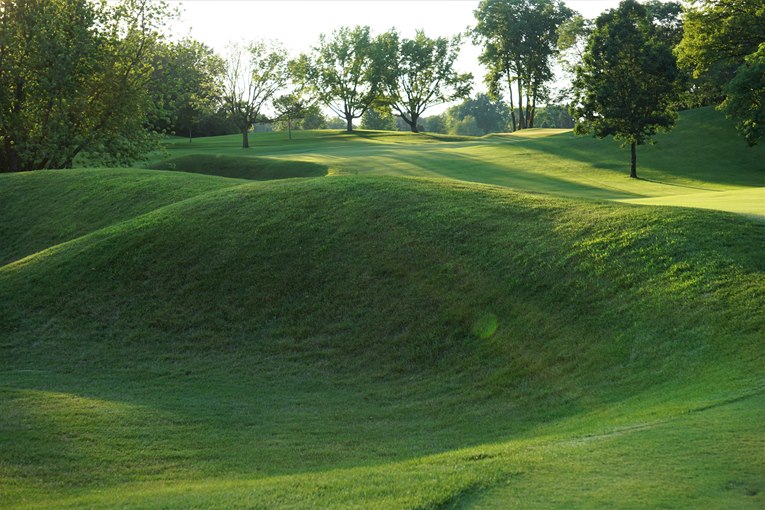West Bend Country Club
Wisconsin, United States of America
Golden Age clubs don’t get to select their history. The architect is predetermined as is how the club treated his work over the first century. All any club can do today is act as the best possible custodian for their course. Take a look at West Bend Country Club. In recent times, it has grappled with some particularly interesting conundrums and via a series of sound decisions and expert in-the-dirt work, has emerged as a must-see joy for architecture fans.
To paraphrase Charles Dickens, West Bend is a tale of two nines. Its front nine opened for play in 1930 and was designed by the Chicago firm of Langford & Moreau. As much as any Golden Age course with which the author is familiar, it expresses similar design tenets to Huntercombe in England, heralded for being one of the first groundbreaking inland designs in the United Kingdom. Opened in 1901, Willie Park Jr’s Huntercombe featured bold sweeping green contours, giant depressions, and a paucity of bunkers. It was – and still is – wildly entertaining to play and remains a strategic marvel. In fact, in recent years with seemingly every modern design fixated on large swathes of sand that present well on Instagram, Huntercombe’s stock has risen even higher. Golfers have come to appreciate that many architects can build handsome bunkers but far fewer are adept at building imaginative green contours and imbuing their courses with strategy that makes them fun to play on a continual basis.
And that is what occurred at West Bend when Langford & Moreau set about building the front nine in the fall 1928. As holds true with their finest designs, much of the land was left at grade from tee to green. Invariably though, a jaw dropping green complex seamlessly arises out of nowhere with contours and slopes that the golfer may well never have experienced before. The green pads range from big to biggest. For instance, the smallest at West Bend is fittingly at their Short hole but still measures over 6,000 square feet. Meanwhile, the largest (the fourth) is well over 12,000 square feet. Standouts abound: the defiant, fortress green pad at the first, the ‘hit-me-or-else’ Knoll second green, the 40+ yard deep third green with a several foot step down in the middle of the green and the volcano seventh.
What the golfer doesn’t contend with are bunkers; there are only eight on the first nine. Instead, similar to Huntercombe, depressions are employed, which need to be avoided with the same vigor and respect as bunkers (indeed, the club and its consulting architect refer to the depressions as bunkers as the two serve the same strategic and penal purposes). More so than at Huntercombe, Langford & Moreau built up the back walls of these depressions, giving them a particularly cavernous appearance. Additionally, these walls obfuscate one’s view and create uncertainty. When layered on top of the roly-poly undulations that were created by glaciers thousands of years ago, the golfer plays a guessing game with the architect, as he is left to wonder what is just over the hillcrest or beyond a depression.

Right at the opening bell/hole, the golfer confronts an impressive depression followed by a bewildering green.
Langford & Moreau’s work commenced before the Great Depression but the broad collapse of the U.S. economy put the second nine on hold. Alas, one world event after another ensued and it wasn’t until 1960 that the club decided to augment the first nine with a second nine. William Langford and Theodore Moreau had both passed so the club turned to regional architect David Gill.
What did he do? Well, the most curious thing is what Gill didn’t do: build the second nine as designed by Langford & Moreau. The club had the plans and shared them with him. The same land was available but Gill eschewed their routing for one of his own, which on several holes, goes in the reverse direction from what his predecessors devised. For instance, his tenth plays uphill away from the clubhouse in the same playing corridor as Langford & Moreau’s eighteenth, which came downhill toward the clubhouse. Same for his eighteenth: it comes down the hill that Langford & Moreau had their tenth play up. To Gill’s credit, many of the holes flow well across the land but he also didn’t make any effort to tie his holes aesthetically or strategically with those of the first nine.
What is a club to do?! There is no road map or manual for handling such an one-off situation. To repeat, a club doesn’t get to choose its history and if it did, it certainly wouldn’t elect to have its nines open 30 years apart by two architects with different styles. Starting in 2008, a small group at the club lead by member Mike McGuire realized that one sure move would be to make the Langford nine as compelling and authentic as possible. Afterall, the club was truly fortunate to have their handiwork, why not make the most of it?
To help them recapture Langford & Moreau’s distinctive style, they turned to St. Louis based architect Kye Goalby. For his part, Goalby has long listed Macdonald’s Saint Louis Country Club as a personal favorite and Macdonald’s own work was of primary influence to Langford & Moreau. Additionally, Goalby already had experience working on a Langford & Moreau. In fact, he grew up a few blocks away from their design at St. Clair Country Club outside of St. Louis. His Dad, Jay Haas and Jerry Haas all learned to play there, so Goalby was thrilled in the late 1990s to begin exposing and re-introducing Langford & Moreau features at St. Clair.
Goalby normally speaks with restraint and, unusual for an architect, isn’t prone to embellishment. Yet, in discussing the underappreciated duo of Langford & Moreau, Goalby is unstinting in his admiration:
Langford and Moreau golf courses are so damn good but it’s hard to put your finger on what exactly makes them eternally captivating. The obvious feature, which is likely what golfers first notice at any Langford and Moreau course, is the large scale, dramatic and bold, grass faced bunkers. These bunkers, which almost always tend to angle back at the golfer (not unlike the forward slash on a keyboard) aren’t just for looks, they dramatically break up playing corridors and provide ideal examples of the concept “line of charm.” However, Langford and Moreau’s boldness didn’t stop at the bunkering. Their greens, both in placement and contouring are equally bold, to the point of sometimes being outrageous, either in contouring (West Bend 3) or location (West Bend 2, 7). The real lifeblood of great golf design is greens contouring. Langford and Moreau created some of the most interesting, varied and creative contouring you will find in the United States and they are all done on blank slate fill pads! Their greens, almost always consisting of receptive swales which seamlessly flow to more difficult, yet accessible, gentle crowns, provide endless interest to approach shots while providing just enough fear of missing in the wrong place to always keep a player engaged and aware. And in my case, smiling.
West Bend had their man in Goalby and together with Green Keeper Brian Bonlender, the nucleus for forward progress was in place. Bonlender started on the maintenance crew in 1998 and was familiar with every inch of the property. Job one for every Green Keeper is to provide playing surfaces conducive to good golf. Yet, this part of Wisconsin features a stunning array of specimen trees, from maples to mighty oaks. No surprise to learn that tree growth had overwhelmed the course. The tree growth was particularly regrettable here because it hide the property’s ace attribute: the course is on the edge of a Kettle Moraine, a region in Wisconsin that was shaped by glaciers more than 10,000 years ago (Erin Hills, host site of the 2016 U.S. Open, lies in the same region). West Bend’s landforms more than its trees are what make the property a standout for golf.
Additionally, the shade and lack of air flow doomed the playing surfaces and the ball wouldn’t properly release, either across the billowing fairways or on the large putting surfaces. As Goalby described above, the heart of playing a Langford & Moreau course is figuring out how to get balls to chase to certain hole locations. In 2008, two giant maples virtually overhung the second green. Fifty foot oaks blocked the view down the right of the third fairway. These were great trees but such trees proliferate in this area north of Milwaukee. They were horrifically in the wrong places on the course. Action was paramount and in member Gary Sullivan, the two men had their champion. Sullivan secured the green light from the club board to strategically remove poorly located trees and to let the course – and property – breathe again. Once a club prioritizes putting golf first, great things follow.
As trees were removed, Langford & Moreau’s architecture began to pop and Bonlender now enjoyed the ability to firm up the playing surfaces. Goalby commenced bunker work, first at the ninth where he more than doubled the size of the two greenside bunkers (as seen in the cover photograph at the top of this page) and returned the bunker bottoms to their original depth. Then, he went to work on the eighth. Take a look below at the elegant, L shaped bunker that creates the playing tension at the one shot eighth. Despite the boldness of Langford & Moreau’s work, it enjoys clean lines. This lack of fussiness helps explain why their work looks peaceful upon the land, despite the massive earthworks associated with their green pads.
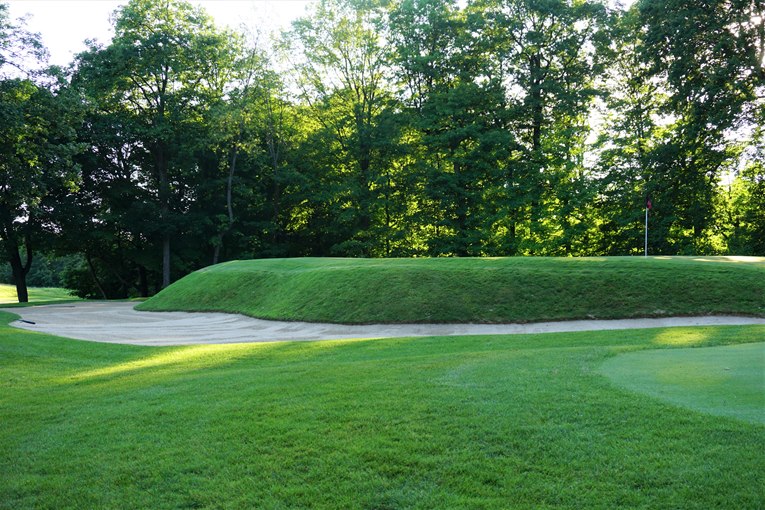
Pre-Goalby, the sand had been flashed up in a manner inconsistent with Langford & Moreau’s flat bottom bunkers. All is well now!
As the trees came down on the front and as the bunkers were re-presented properly, word started to percolate in certain golf circles that perhaps West Bend possessed the finest nine holes in Wisconsin. High praise indeed for such a golf rich state! One consequence though was that the difference in quality between the two nines became even more glaring. Irritatingly, the possibility of building Langford & Moreau’s second nine still exists – no interior homes or roads have been built that make it impossible. The will to do so exists within a dedicated band of members but the cost is prohibitive. Therefore, the logical conclusion was to make the two nines feel like they are part of the same golf course, as opposed to being so overtly architecturally distinct. Translated, that meant that Goalby was to imbue the second nine with as many Langford & Moreau elements as possible. Goalby started in 2012 on the second nine with the fourteenth hole and as of the summer of 2019, marked progress has been achieved on holes ten through fifteen. Work on the final three holes is hoped to occur in the fall 2020.

The 14th hole in 2012 showed no architectural attempt to make it look like it flows from Langford & Moreau’s first nine holes.

Roll forward to 2019 and Goalby’s progress tee to green is evident. Typical of the second nine, the 14th possesses beauty and fine undulations everywhere but on the green.
A few points: the best holes are found on the first nine and yet, the argument can be made that the property is even better, more roly-poly on the back. Such is the value of great architects and their work. The heart breaks that Langford & Moreau’s plans for the second nine weren’t followed. Who knows what magic they could have created? However, little value is placed ‘in crying over spilt milk.’ The membership is a full and active and what they want is the best golf today. As we see below, they are a lucky lot.
Holes to Note
First hole, 420 yards; The influence that Chicago Golf Club held over Langford & Moreau can’t be overstated as it houses many of the template holes favored by C.B. Macdonald. Langford & Moreau were clearly fans not only of the strategy such holes espoused but also of the construction techniques used to render them whereby everything is essentially at grade tee to green followed by a monster green pad. Similar to Chicago Golf Club, a pair of tough two shotters kick the round off.
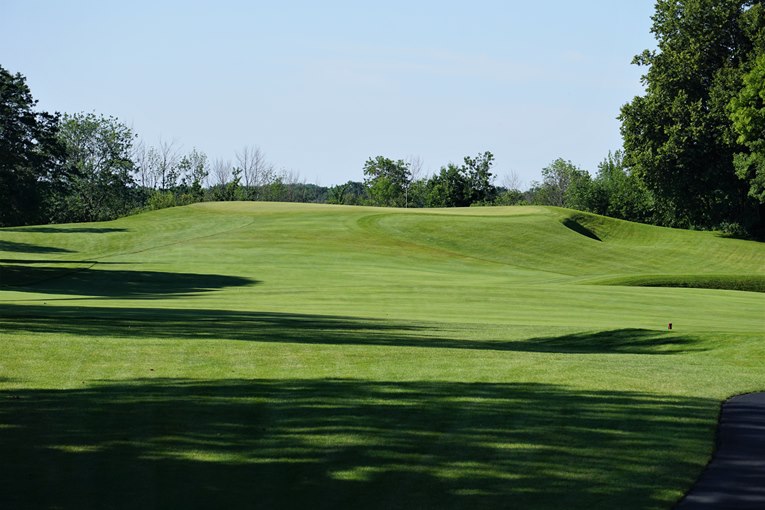
The golfer’s attention is grabbed the moment he stands on the tee – that’s a good omen as it portends to time being well spent, especially as the first is a microcosm of things that will follow. Note the graceful potato-chip wavy qualities of the 1st putting surface.
Second hole, 440 yards; The Golden Age architects prided in giving their courses strategic worth. If the golfer could accomplish something, then he was rewarded with a simpler next shot. In that manner, Golden Age courses never become a chore to play. Rather, the golfer looks forward to tackling the diverse questions asked of his game. Take the second hole as a fine example. Langford & Moreau flowed a depression into the fairway off the left hillside. Can the golfer carry it or at least skirt past it and therefore enjoy a clean look at the knob green?
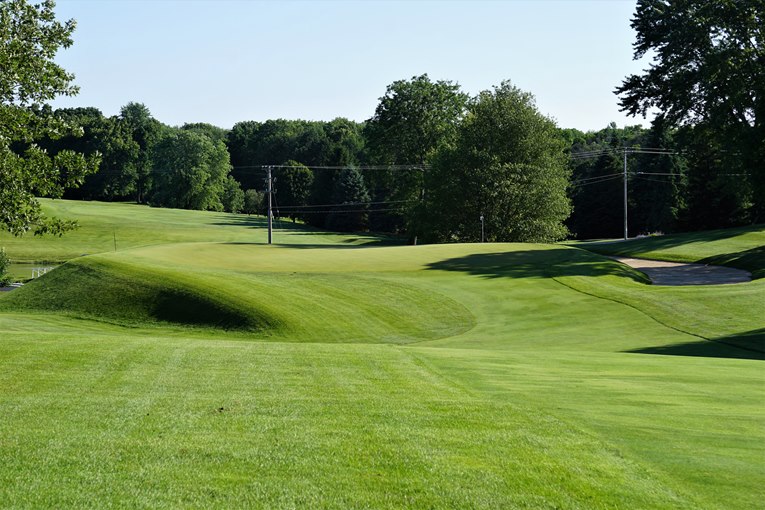
… with this view of the mighty 2nd green complex. Where did Langford & Moreau gather the fill to build such a monster pad and how did they make it look so graceful?! Those are some of the delightful mysteries in architecture.
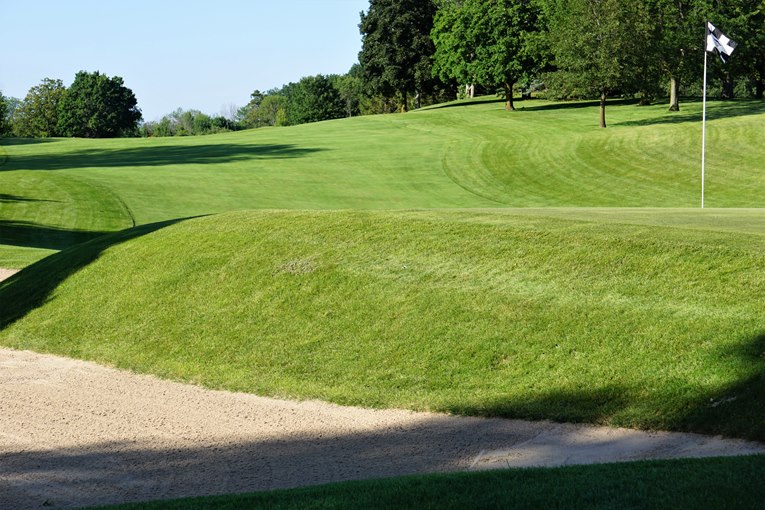
As seen from behind, today’s far right hole location occupies a small shelf and is particularly evil. A blocked approach leaves the golfer short-sided and his 4th shot will likely be from 40 feet away.
Third hole, 520 yards; Rarely does the golfer find a set of three shotters with such grand movement. The first one is the ‘flattest’, which is relative! And it is also the best, thanks to one of the most imaginative greens built during the Golden Age of architecture. Even by Langford & Moreau’s own high standards, the third green is a standout.
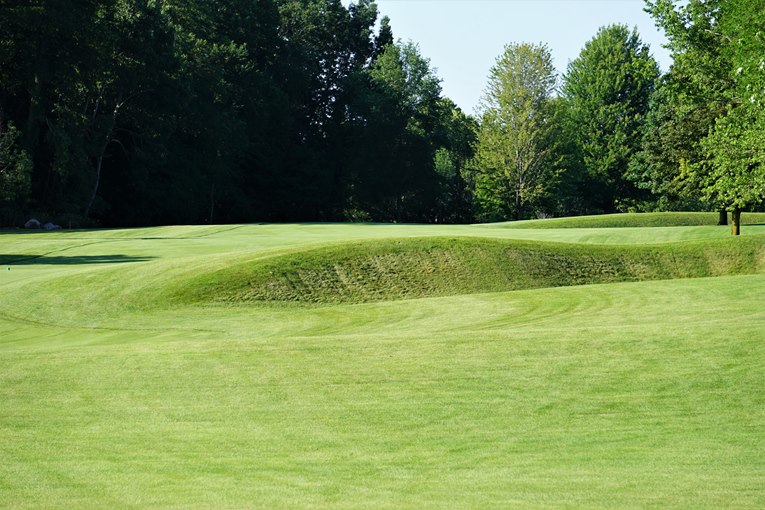
A bunkerless three shotter with lots for the golfer to accomplish. Job one is not to get tangled up in the depression in the foreground off the tee.
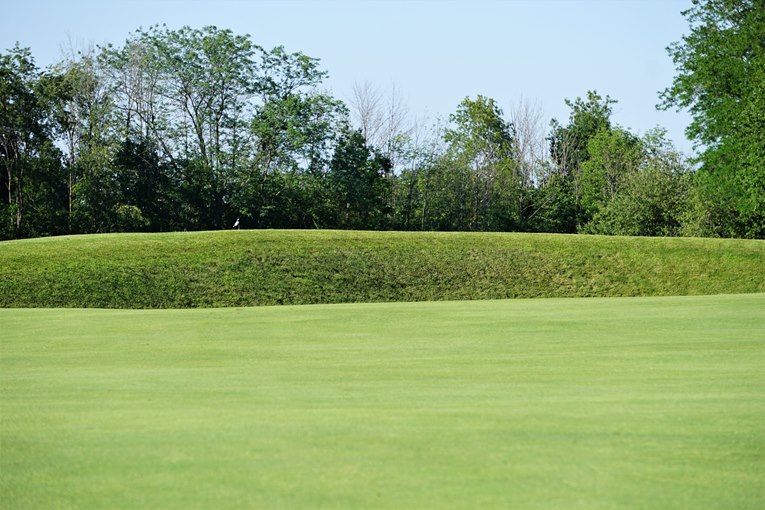
Job two is to get past the next depression or else face this teasing shot with only the flag visible. Rest assured that Langford & Moreau worked diligently on the height of the wall of the depression to achieve this exact visual.
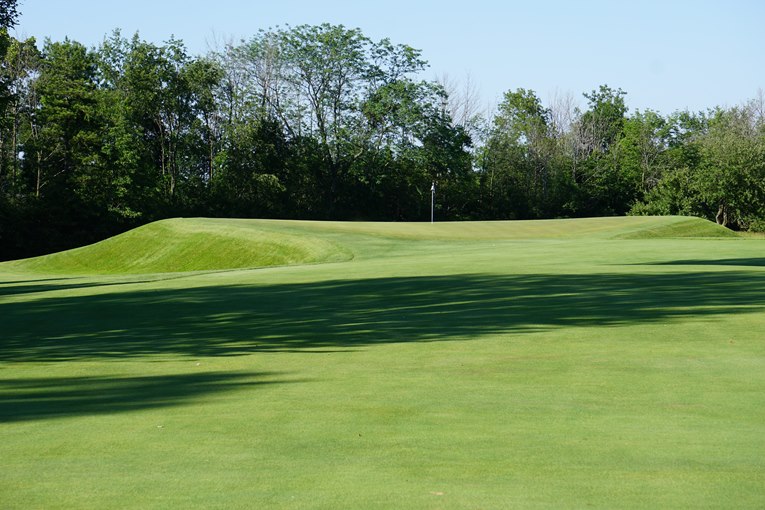
Seemingly innocuous, the 3rd is anything but as demonstrated in the side view from high right in the photograph below.
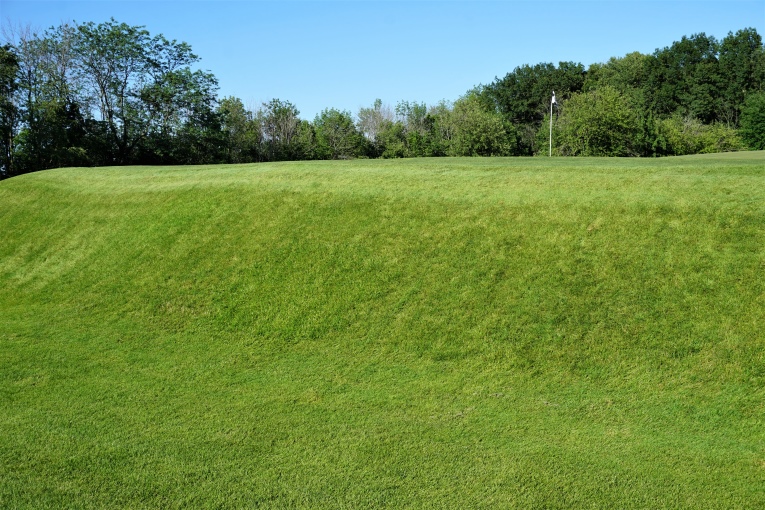
A pull left of the green leaves the golfer no view of the putting surface, which speaks to the height of the green pad.
Fourth hole, 215 yards; As pointed out throughout this profile, Langford & Moreau had a style. If the golfer likes it, then he invariably will be enthralled whenever he discovers a well presented Langford & Moreau course. They seemingly always found a way to knock character into a hole. The eighteen holes at Lawsonia, the nine holes at Culver Academies and the nine holes at West Bend stand as testimony. Seriously, what is the worst of those thirty-six holes? The steps the author would take to answer that question are to identify the holes on the most mundane property and then see if any candidate emerges. As all three courses occupy exceptionally fine rolling land, not many obvious selections present themselves. One that might is this one shotter. A rural road makes its presence felt along the fourth and fifth holes and otherwise, West Bend Country Club enjoys a uniquely quiet environment for a game. The landforms are more muted here at the edge of the property so what did Langford & Moreau do? Build a corker of a 12,125 square foot green complex, which makes this hole anything but ordinary. Indeed, back left hole locations are the most vicious on the property.
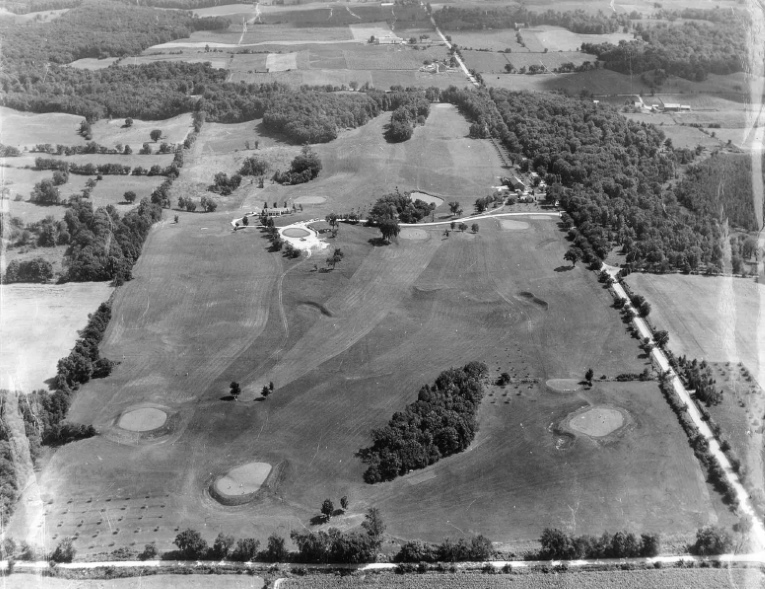
This 1930s aerial shows the open – and bunkerless – nature of the property. Only the 7th and 8th holes are in the forest to the south; the rest of the front nine is visible. The impressive 3rd green complex is bottom middle and the slightly larger one at 4 is bottom right.
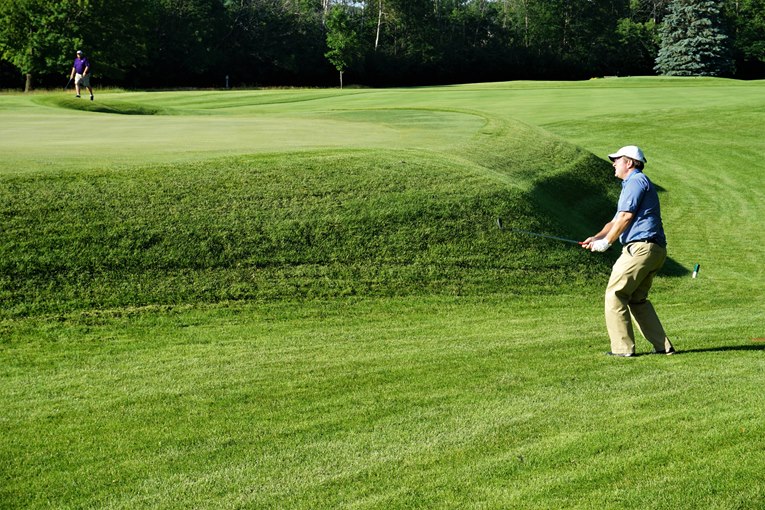
Short grass profilerates around many modern greens but that was not how Langford & Moreau built their courses. Above is a typical recovery shots – be sure to bring a 60 or even 64 degree wedge.
Fifth hole, 390 yards; As seen below, the tension below is created from depressions on the left some 200 yards from the tee and a specimen silver maple tree farther ahead on the right. The eye gravates to the depressions left and therefore the tree right has become the menace over time. The maple’s influence is much more pronounced today than in Langford’s time when it was half the size (as seen in the black and white aerial photograph above) but it acts as a fine counterpoint to the 460cc titanium head that Langford & Moreau never saw coming.

Photography is easy when working with an impressive sandscape, just click and shot. Yet, West Bend is equally easy to photograph, though for entirely different reasons. Bonlender notes that ‘Our grass depressions are maintained by yearly fertilization, irrigation as needed and a vertical climbing mower (Steiner) along with a hover mower that will mow from the top down to clean up anything our Steiner cannot reach. Let’s also not forget the strong backs that it takes to use the hover mowers!’
Sixth hole 555 yards; Too many three shot holes tolerate loose shots. In theory, long holes should build on the success of the prior shot and that is what happens here: the drive absolutely needs to find the fairway in order for one’s second to scale the formidable hill that falls 360 yards from the tee. If successful, the short iron approach may well set up the desired birdie. Yet, a poor tee ball or second shot and the golfer is likely fighting a losing battle with the land.
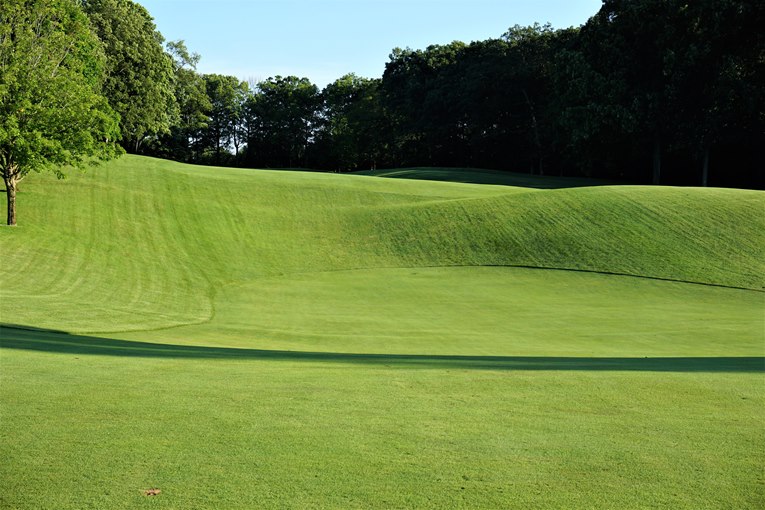
Not unlike the sixth at Pebble Beach, the sixth plays to a lower fairway before stair-stepping up to a higher plateau.
West Bend Country Club
Wisconsin, United States of America
Seventh hole, 360 yards; A beloved hole, one of the best in the Midwest, and one where the opportunity for huge embarrassment effortlessly presents itself. The author’s brother John Morrissett noted long ago, ‘If you want to see how good a hole can be that is bunkerless, measures well under 400 yards, features no water, and yet places high demands on the player, come see the seventh at West Bend.’ Right he was! Rarely is a tee ball so important but with a depression right, don’t be fooled into going left in an effort to shorten the hole. The only thing that likely guarantees is a shot from the rough at an oblique angle to a firm green – a losing proposition. Far better to fly over or skirt past the depression and approach the elevated green from the outside of the dogleg. Like with so many great holes, trial and error is required to discern how best to handle this little brute. Just don’t look at the scorecard and assume ‘birdie hole’ because even the best can get mangled fighting these rambunctious landforms.
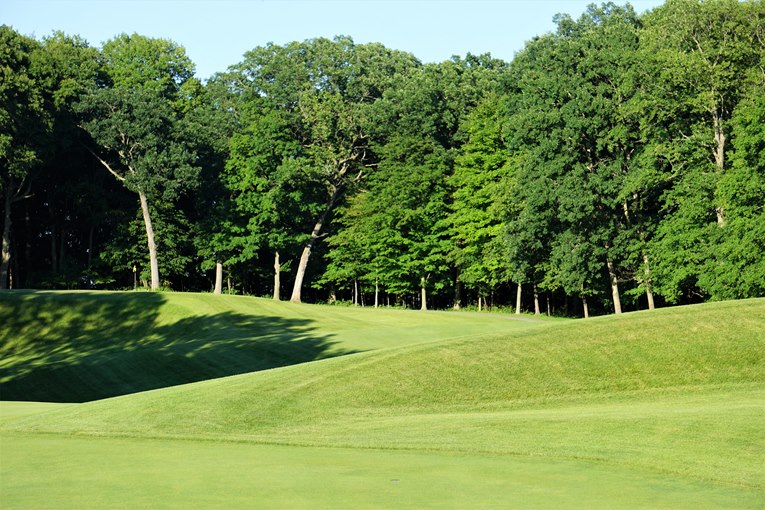
Once down in the fairway, the criminally elevated green and flagstick reveal themselves. Goalby elaborates, ‘Illustrating bold locations, the 7th is a great example of their willingness to be daring. Identifying a green site that most, if not all, other architects would try to lower or soften, they added dirt and pushed it even higher! In doing so, they created an unforgettable hole.’
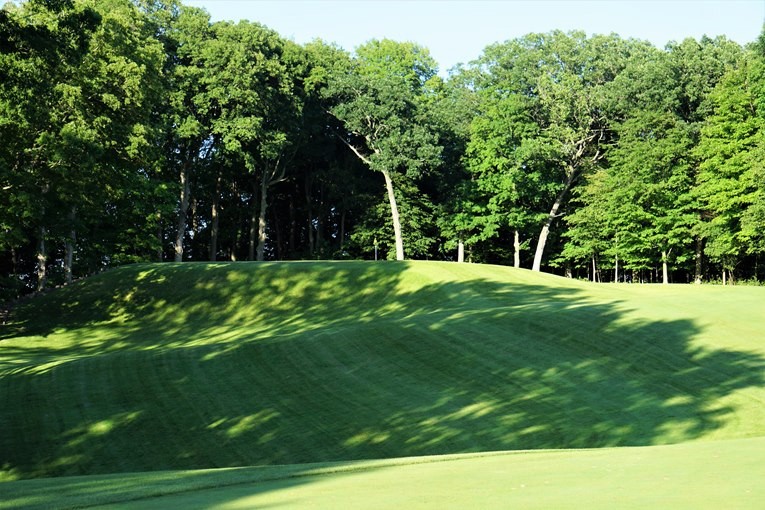
Even the modern golfer feels hard done by and ill-equipped to handle this daunting approach from anything other than short grass.
Eighth hole, 160 yards; Bob Jones won the Grand Slam using hickory clubs in 1930, the same year that this nine opened. Just think of what it would have been like with hickory clubs to tackle this nine. In this case, miss the green short or left and good luck with your recovery from five feet below the green surface with a ~45 degree hickory club. Even with today’s 64 degree wedges and exotic fiber shafts, this clean, simple looking hole packs a punch. Most members play it at 138 yards and the beauty of any Short hole is the tension created between the hole’s de minimis length versus the peril of missing the green. Essentially, the challenge is to not let the short distance woo the golfer into greedy tactics of chasing perimeter hole locations but rather to see if the golfer has the composure to hit for the middle of the green, even with a short iron in hand.

To play the 8th, you have to first get to the tee, which is accomplished by descending 35 steps from left of the 7th green.
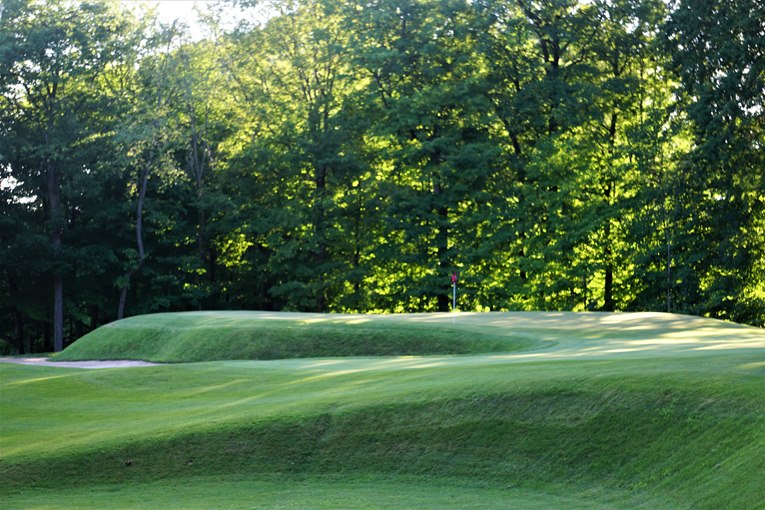
The filtered light that reaches the putting surface is vital to healthy turf and is a direct consequence of the club’s prudent tree thinning that has occurred over the past decade.
Ninth hole, 475 yards; What a grand, sweeping 1/2 par hole. The fairway catapults from high right to lower left and then twists to the green where it is higher on the left than the right. Sites with more pedestrian land movement are incapable of yielding such visceral excitement. And of course, Langford & Moreau’s bold man-made features (a pair of twelve foot deep depressions 40 yards shy of the green, another enormous green punctuated by deep bunkers at its base) exacerbate the thrilling challenge that comes from tumbling landforms and pronounced features. If there are many better holes in the Midwest than this one, the author hasn’t seen them and it, along with the third and seventh, are certainly shoe-ins for best eclectic Langford & Moreau holes. After playing the hole, remember you are in Vince Lombardi country and his words, ‘The greatest accomplishment is not in never falling, but in rising again after you fall’ will resonate anew!

A+ for routing, as Langford & Moreau captured the marvelously convoluted landforms of the kettle moraine within the 9th’s playing corridor.

What constitutes great architecture? One litmus test is do you want to drop a small satchel of balls from a spot and hit the shot until you get it just right. The approach to the 9th passes that ideal with flying colors.
Tenth hole, 355 yards; This is a key moment in the round as the Langford & Moreau holes are over, yet the high octane stretch from seven to nine only has the golfer panting for more. Naturally, more than a tinge of regret surfaces, so how the club handles the transition is critical. Some holes do it exceptionally well (the third at Bandon Trails is so alarmingly good that the golfer could not care less that he is back is now turned to the Pacific Ocean) while other holes (the sixth at Spyglass Hill) leave the golfer mourning the departure from the coastal environment. At West Bend, the well placed, confrontational depressions on the front nine are so striking, so handsome that the golfer yearns for such features to appear on the second nine just as they would have if Langford & Moreau had built both nines. And now, with Goalby’s recent addition of depressions left and right, the golfer is provided a sense of relief as he stands on the tenth tee as the enticing architecture compels him forward. This is no mean feat and the club and Goalby deserve applause for the smooth transition.

The golfer can be forgiven for thinking that Langford & Moreau built this hole given the scooped out depression short right and …
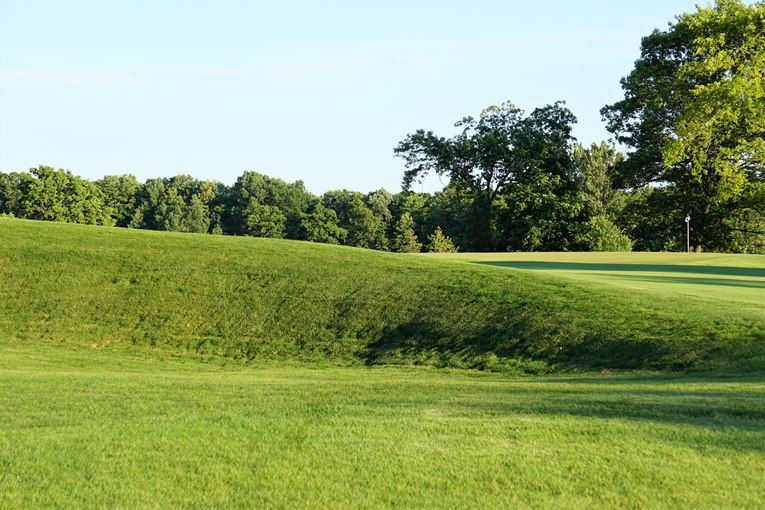
… the one long left. This view from 135 yards feeds off the design ethos established on the front nine.
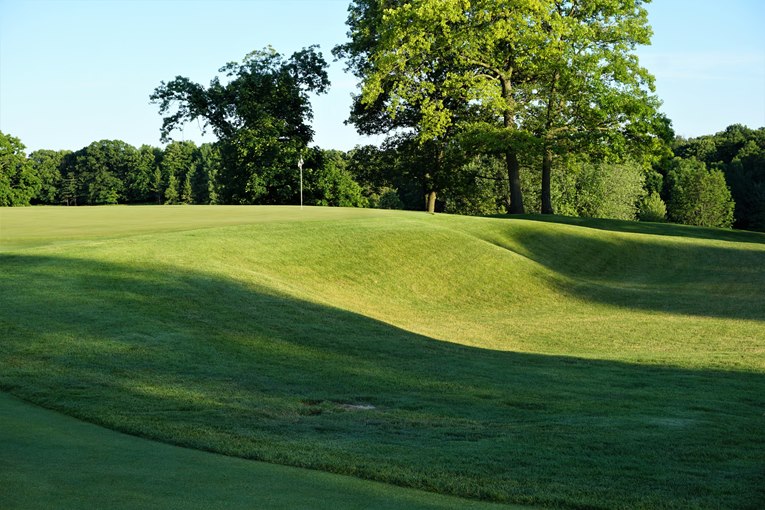
A pushed approach leaves the golfer with the sort of recovery that he likely already experienced on the front.
Eleventh hole, 525 yards; Fawning over Langford & Moreau’s routing for the second nine is a natural consequence derived from the quality of the first nine. And yet, the commanding downhill view found here is so compelling, that one is shocked to learn that Langford & Moreau routed their hole (the seventeenth) up this hill. No doubt they had good reason but … today’s hole offers undeniable drama and a visual appeal.
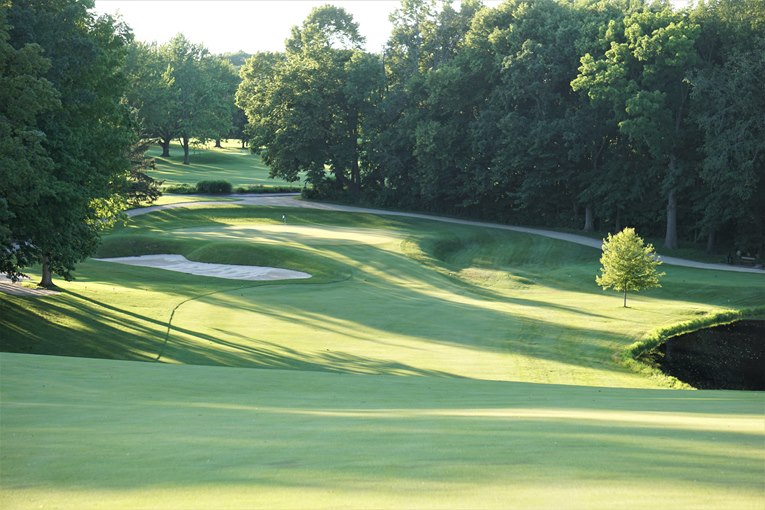
A big drive leaves the golfer some 230 yards away and presents a tempting risk/reward moment. A well struck shot hangs in the air forever.
Twelfth hole, 350 yards; Save for tamer green contours, the golfer hasn’t seen any jarring design features relative to the front and he is now three holes into the second nine. That was untrue in 2014 and it shows the marked progress that has been made in a short period. Indeed, it is the work on the back that has led to West Bend’s jump in stature, even more so than the work and de-forestation that occured on the front. The depressions off the tee are most notable but Goalby’s work right of the green in building a soft, grass hollow has several members contending this is the course’s most improved hole.

Mission accomplished – Goalby’s depressions on the outside of the 12th fairway look like they have been here since 1930.
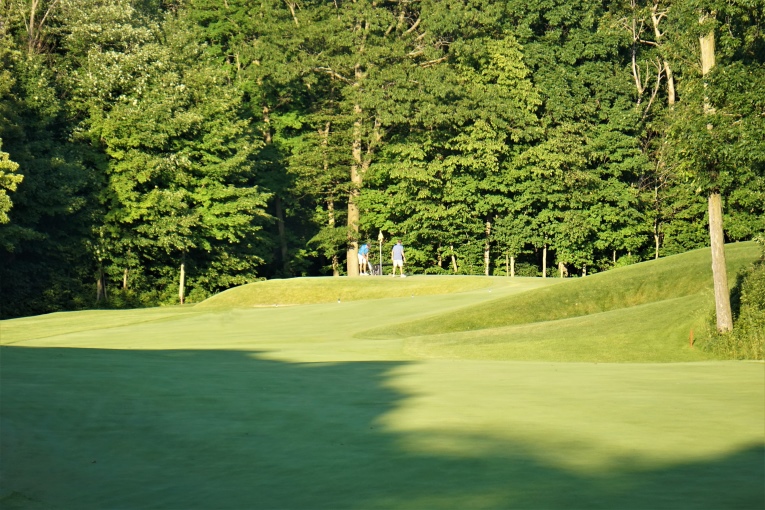
Stay below the hole on 12 as both it and the 11th green feature enough pitch to keep the golfer on his toes.
Fifteenth hole, 535 yards; Give Gill credit for this hole’s clever, twisting routing and Goalby credit for making it enjoy Langford & Moreau attributes. The result? In addition to perhaps the twelfth, this one exemplifies just how good West Bend can become as an eighteen hole course. Set over scintillating land, the hole jogs past a set of Goalby depressions left and right before finishing at the best green on this side, courtesy of Goalby adding character and flair when he completely rebuilt it from the ground up in 2015. From start to finish, there is much to admire including the switchback nature of the hole. For a big hitter, a draw off the tee is required followed by a fade into the green; asking people to shape a ball might seem old fashioned, which is exactly the point. Welcome to the Golden Age and the Kettle Moraine.
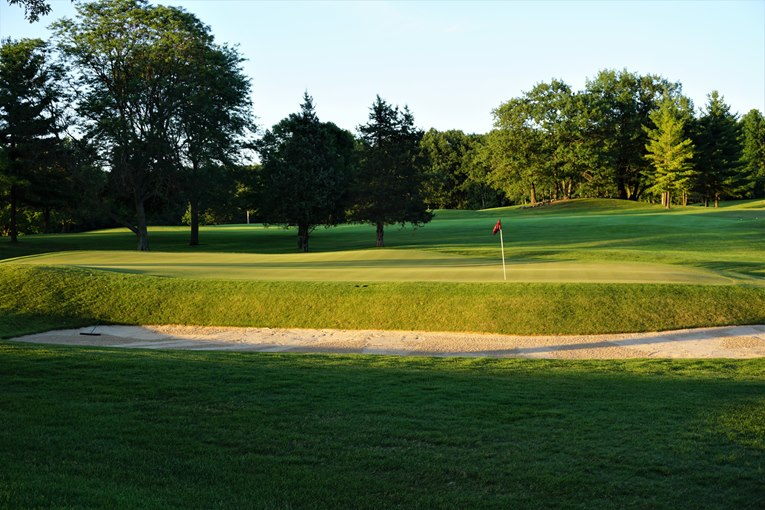
As seen from the left, the afternoon sun highlights the best green contours found on the second nine.
The least distinguished three hole stretch on the course today is the last three because Goalby has yet to tackle them; they remain out of character with the prior fifteen holes. Happily though, the land they occupy is full of promise. Existing ideas for the sixteenth hole hold wonderful promise while redoing the last one hundred yards of the Home hole is monumentally important. After that is accomplished, West Bend Country Club will enjoy ardent support for being in the top five in one of the country’s best golf states.
Even though much (!) has been accomplished, West Bend Country Club remains a work in progress. While it isn’t a homogeneous playing experience in the sense of Pinehurst No. 2 or Sand Hills, few courses possess West Bend’s quantity of superlative holes. The fact that they mostly fall on the front nine might remind some of Royal County Down where the two nines aren’t interchangeable in quality either. However, the disparity in quality at West Bend is the smallest that it has ever been, and that is in spite of all the fine work accomplished on the front nine. The front’s overwhelming merit combined with the dramatic vistas on the back (e.g. the eleventh and fourteenth) and good golf (e.g. the tenth, twelfth, fifteenth) and the conclusion is inescapable that West Bend offers thrilling golf in an inspired Kettle Moraine environment.
One curious fact is that the Golden Age nine (3,539 yards) actually measures 200 yards longer than the modern nine (3,348). Both play to the same par of 36, so the delta isn’t explained by the modern side having one less three shotter, for instance. Given that the combined nines total nearly 6,900 yards, one could be forgiven for saying, so what? The biggest knock that the author has on Gill’s routing is that it yielded three two shotters (the tenth, fourteenth and here) that fall within a tight, seven yard range of one another. Combined with two par fives, the golfer might have a wedge approach to a majority of holes on the second nine. Meanwhile, Langford & Moreau’s collection of holes show a greater spacing of yardages, and require a wider variety of approach shots, which is always desirable.
This point is amplified by the fact not only is the front longer and requires a greater range of approach shots, its greens are also far and away more interesting. The second nine sorely needs interior contours akin to those at the first, second, third, fourth, etc. Just as the club did with Goalby at the fifteenth, here’s to hoping that they let him breathe the same kind of fire into the second nine greens. Such a process is not exorbitantly expensive nor time consuming as the club found out at fifteen. The greens at the modest length tenth and fourteenth would be the biggest beneficiaries. Also, it is worth noting that Byron Nelson once made a disparaging comment regarding some rambunctious contours in the sixth green, which lead to those being softened. No doubt Goalby would love to have a crack at restoring the high left side with a lowered back right bowl at the sixth.
The restoration movement in the United States in the early 1990s began with Donald Ross courses and expanded later that decade to include C.B. Macdonald and Seth Raynor. Soon thereafter, other design titans were appreciated and their work was put on a pedestal too, including William Flynn and A.W. Tillinghast. It wasn’t until this century though that the spotlight turned to William Langford and Theodore Moreau and when it did, people realized what a huge oversight that had been. With designs like Lawsonia Links, Culver Academies, and West Bend leading the way, people are again swooning.
The End



